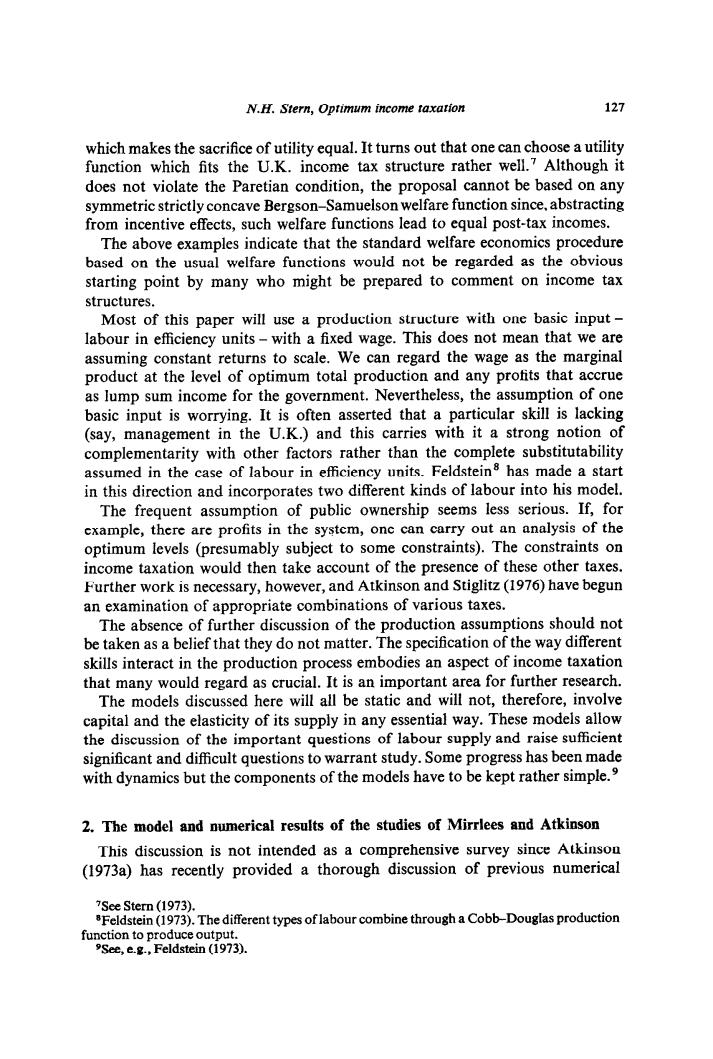正在加载图片...

N.H.Stern,Optimum income taxation which makes the sacrifice of utility equal.It turns out that one can choose a utility function which fits the U.K.income tax structure rather well.?Although it does not violate the Paretian condition,the proposal cannot be based on any ncave Bergson-Samuelson welfare function since,abstracting in ntive effects such welfare functions lead to equal post-tax incomes. The abov ve examples the standard welfar e ec ics dure based on th usual welfar o" would no starting point by many who might be prepared to comment on income tax structures Most of this paper will use a production structure with one basic input- labour in efficiency units-with a fixed wage.This does not mean that we are ea6eeagae mp the basic input ome for g0 t.Nevertheless,the assumption of one s worrying icular skill is lacking 4 h stror complementarity with other factors rather than the omple e sub titutab assumed in the case of labour in efficiency units.Felds has made a star in this direction and incorporates two different kinds of labour into his model The frequent assumption of public ownership seems less serious.If,for cxan aple,there are profits in the system,onc can carry out an analysis of the optim els esumably subiect to some constraints).The constraints on income tax would th take t of the esence of these pre other taxes r work is neessary,h wever iglitz(1976)have begu an examination of appropriate comb dons of ious taxe The absence of further discussion of the production assumptions should not be taken as a belief that they do not matter.The specification of the way different skills interact in the production process embodies an aspect of income taxation that many would regard as crucial.It is an important area for further research The models discussed here will all be static and will not,therefore,involve elasticity of its supply in any essential way.These models allow the ue apply and raise sufficien cant ar tions to w ss has been mad with dynamics but the components of the moc have to le 9 D rather simp 2.The model and numerical results of the studies of Mirrlees and Atkinson This discussion is not intended as a comprehensive survey since Atkinso (1973a)has recently provided a thorough discussion of previous numerical Sce Stern (1973). The different types oflabour ough a cobb-douglas productionN.H. Stern, Optimum income taxation 127 which makes the sacrifice of utility equal. It turns out that one can choose a utility function which fits the U.K. income tax structure rather well.’ Although it does not violate the Paretian condition, the proposal cannot be based on any symmetric strictly concave Bergson-Samuelson welfare function since, abstracting from incentive effects, such welfare functions lead to equal post-tax incomes. The above examples indicate that the standard welfare economics procedure based on the usual welfare functions would not be regarded as the obvious starting point by many who might be prepared to comment on income tax structures. Most of this paper will use a production structure with one basic input - labour in efficiency units - with a fixed wage. This does not mean that we are assuming constant returns to scale. We can regard the wage as the marginal product at the level of optimum total production and any profits that accrue as lump sum income for the government. Nevertheless, the assumption of one basic input is worrying. It is often asserted that a particular skill is lacking (say, management in the U.K.) and this carries with it a strong notion of complementarity with other factors rather than the complete substitutability assumed in the case of labour in efficiency units. Feldstein* has made a start in this direction and incorporates two different kinds of labour into his model. The frequent assumption of public ownership seems less serious. If, for example, there are profits in the system, one can carry out an analysis of the optimum levels (presumably subject to some constraints). The constraints on income taxation would then take account of the presence of these other taxes. Further work is necessary, however, and Atkinson and Stiglitz (1976) have begun an examination of appropriate combinations of various taxes. The absence of further discussion of the production assumptions should not be taken as a belief that they do not matter. The specification of the way different skills interact in the production process embodies an aspect of income taxation that many would regard as crucial. It is an important area for further research. The models discussed here will all be static and will not, therefore, involve capital and the elasticity of its supply in any essential way. These models allow the discussion of the important questions of labour supply and raise sufficient significant and difficult questions to warrant study. Some progress has been made with dynamics but the components of the models have to be kept rather simple.’ 2. The model and numerical results of the studies of Mirrlees and Atkinson This discussion is not intended as a comprehensive survey since Atkinson (1973a) has recently provided a thorough discussion of previous numerical ‘See Stem (1973). 8Feldstein (I 973). The different types of labour combine through a Cobb-Douglas production function to produce output. ?!ke, e.g., Feldstein (1973)